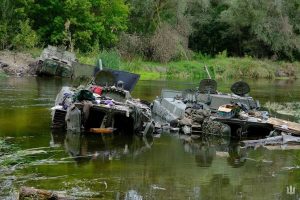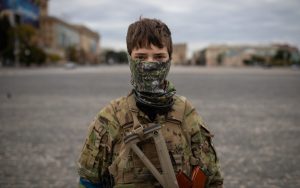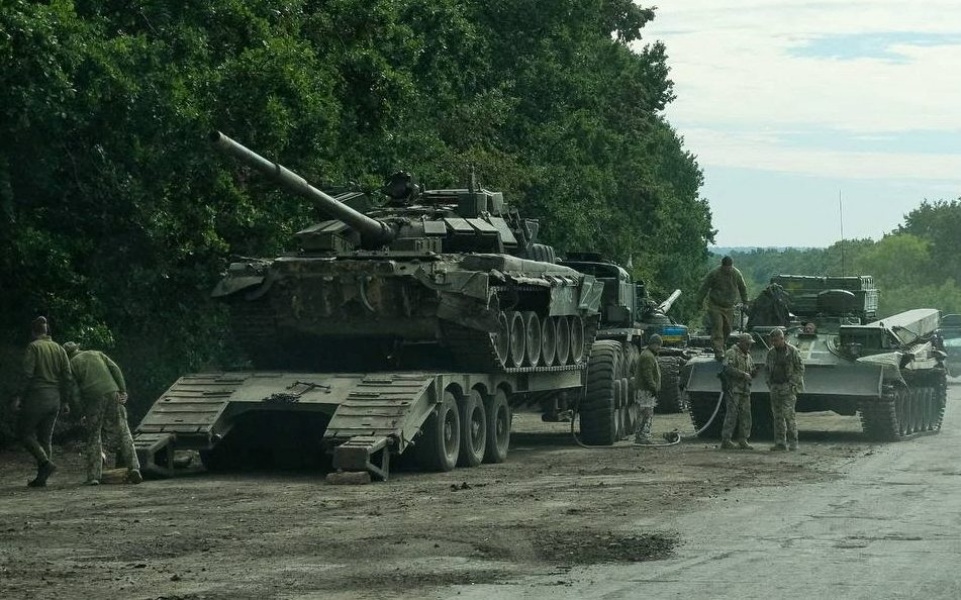Panicked Russian soldiers are abandoning their tanks, weapons and even clothes as they «literally run from their positions» in the face of a shock Ukrainian offensive, soldiers have told The Telegraph, reports The Telegraph.
A Ukrainian intelligence unit on the front line said the Russian chain of command was broken and soldiers were fleeing without putting up a fight, many of them changing into civilian clothes to avoid detection.
A drone operator returning from the front line on Sunday also told The Telegraph that the speed of the offensive had even taken their own army by surprise, with troops struggling to recover the mountains of Russian ammunition and armoured vehicles left behind.
Watching the battles through reconnaissance drones and listening to Russian communications, the soldiers said Russian units were being obliterated before they had time to identify their enemy, while survivors fled amid the chaos.
In one intercepted communication, a commander with the callsign Birdie described hearing a Russian tank unit desperately asking what had happened to their command. “‘We are totally f—ed’.

“Then they fled. Later we found their burned tank.”
The first-hand description of the counter-offensive – one of the first describing an ongoing operation – belies claims by the Russian Defence ministry that Moscow’s retreat from Izium and other parts of occupied Kharkiv was a planned “regrouping”.
“They were really afraid, their chain of command was in chaos. Officers left the area before the fighting began,” Birdie said, describing listening to panicked Russian radio transmissions.
The 31-year-old commands a communications and reconnaissance unit in the Kraken Regiment that returned to Kharkiv from the liberated city of Balakliya on Sunday morning.
Listening in on enemy
The unit had spent a week intercepting radio communications and surveilling Russian positions for a Ukrainian counter-offensive that is estimated to have routed Russian forces from nearly 2,000 square miles of territory since Tuesday.
A volunteer unit formed on the day of Russia’s invasion on February 24, Kraken operates in a grey zone separate from Ukraine’s armed forces but answering to their defence ministry, giving it greater flexibility than other military units to discuss an ongoing counter-offensive that remains under a media blackout.
Having slept little since the operation, and with blue tape still tied around the sleeves of his uniform to identify him as a Ukrainian soldier, Birdie was upbeat describing the counter-offensive.

“It was the coolest thing I’ve ever seen in my life,” he said of his unit’s work coordinating Ukrainian ground forces via drone as they attacked Russian positions.
“I saw small units of up to five of our guys on foot who were destroying huge numbers or Russian vehicles – three tanks at one time,” he added, drinking a coffee on a chilly morning in central Kharkiv.
Russian soldiers and fighters from the separatist Donetsk and Luhansk regions had fled in a rout, he said.
Fleeing Russians
“They left a huge amount of vehicles and ammunition. We couldn’t transfer or evacuate it all to our rear.”
Few of the pro-Russian forces stayed to fight, with many switching into civilian clothes to flee, Birdie added.
“There were a lot of uniforms lying around. We caught some of these guys trying to escape in civilian clothes, they were telling some incredible bullshit trying to save themselves.”
Other Russian troops were unable to distinguish their own forces from advancing Ukrainian troops.
“I heard them asking what were the white crosses on the vehicles. Then I heard them die in real time, while I was listening,” he said.
Tai, a 23-year-old drone operator, said the counter-offensive had advanced even faster than they had planned.

“The hardest task was coordinating all the groups operating inside Balakliya,” she said, describing how they had liberated the city faster than they had initially expected.
A Kraken commander who declined to be identified credited the unit with acting as the brains of a complex counter-offensive with their drones as the eyes.
“We need more drones, we need more more drones!” said Green, a 43-year–old drone pilot in the unit.
Further counter-offensives
The unit is now expecting to redeploy in the near future for further offensive operations.
“I think it’s the beginning of the end for Russian occupants,” said Marty, a 25-year-old in the unit who comes from a Kharkiv village that was liberated last week.
“They were literally running from their positions, leaving their stuff and heading to the occupied territories. I think more significant gains are coming.”


